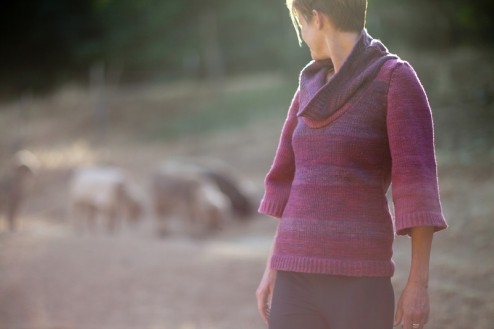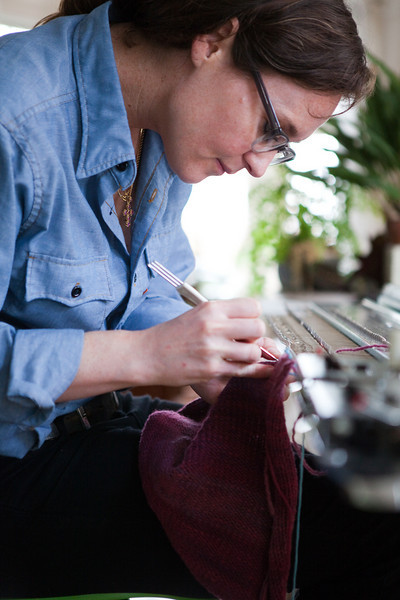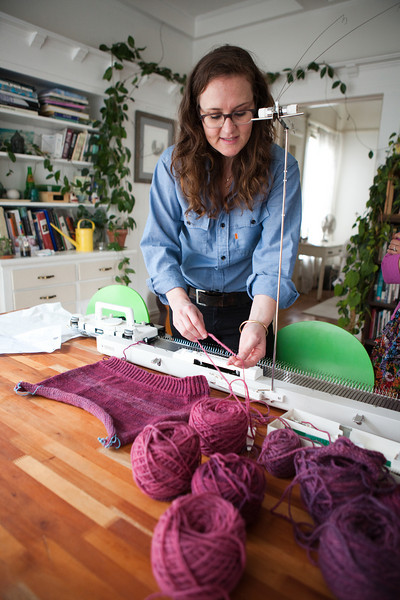The 150 mile wardrobe challenge was a process of invention, innovation, risk and problem solving that existed and continues to exist under an umbrella of unknowns that perseveres in birthing both deeply beautiful garments and equally in depth questions about our material future.
The Fibershed project that sponsored the 150-mile wardrobe is now a non-profit organization that continues to push towards bioregional ownership of ‘soil-to-skin’ processes. In our community where thousands of pounds of wasted fiber has been growing each year for decades, (smack-dab in the backyard of Northern California’s own Bay Area), it’s clear that we have what it takes to grow a large portion of our clothes in more intimate supply chains, (for more on that subject of growing our clothes- click here for our latest Symposium details).
These first glimmers of a more beautiful and reverent textile culture came from the hardworking hands and minds of our local farmers and artisans. It was their collaborations that spawned the jaw-droppingly beautiful garments that have lifted our visual senses, and inspired us to understand what is possible when we bring our talents together.
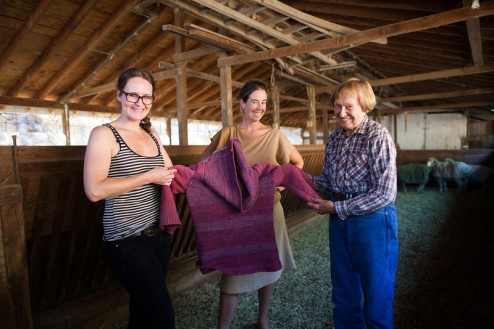
The pokeberry and japanese indigo dyed sweater was made from 100% merino wool from a sheep named Reba, a sixteen year old ewe from Jean Near’s Utopia Ranch in Redwood Valley, Mendocino. The piece was designed and knit by California College for the Art’s graduate Sachi Henrietta– a designer who’s developed a certain notoriety for that sought after combo of brilliant-design-eye mixed with an ability to get the job done.
Sachi’s knitting and design skill was noticed by her CCA professor Lynda Grose, who referred me to Henrietta to assist in the building of the localized wardrobe. Henrietta’s enthusiastic and welcoming character was immediately evident, as she agreed to meet with me in a basement classroom in between finishing up a final project and dashing off to her evening job. I walked into a room filled with a luminous collection of very brightly colored yarns and storyboards covered in the latest trends…I carried with me a jar of pokeberries and a skein of yarn from Reba. Henrietta offered a wide smile, and we got right to business. She drew, measured, and created her vision right there on the spot with a sense of gentle confidence.
Henrietta grew up in Hawaii with the great expanse of the ocean existing as the backdrop to her childhood experience. The immense blue water horizon, and the even keel climate provided a foundation for Henrietta that you can still detect in her character of unwavering consistency and earthy friendliness. “The ocean feels like home and I do love to surf…” she said, as we chatted in her upper Haight St. San Francisco apartment.
Henrietta moved north of San Francisco to Marin County in her early childhood, and by this time she had already begun to take an interest in fiber art and sewing. “My aunt is a fine artist who makes sculptures from paper, I received a lot of inspiration from her, and I even began working for her, helping her at shows, and all sorts of logistics.” After working with her aunt, Henrietta began to look to expand her educational horizons, and as part of her exploration she attended a summer program led by textile professor Lynda Grose. “The workshop I took with Lynda is what led me to my commitment to study fashion.” We did exercises where we looked at the connections between the Iraq war, the environment, and how and what people wear in response to these conditions, it was a total systems thinking moment…I’d never been in a dialogue like that before.”
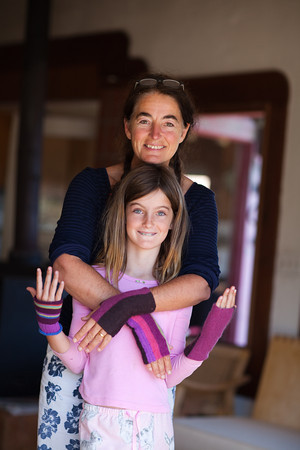
“After that class, I realized fashion needed me, my vision for the health of the environment had a place in in this world.” And that it did, Henrietta’s taken internships with Margaret O’Leary, Abercrombie and Fitch, the Nice Collective in SF, and she is now off to New York. During a recent phone conversation about her move, Henrietta asked if there were Fibersheds on the east coast, and if she might be able to volunteer for one. We discussed the fact that two Fibershed projects are emerging in New York State, and we know Henrietta’s skills could be a huge asset to our Atlantic sister projects.
(Beyond Volunteerism: Someday soon we can forsee that a design graduate like Henrietta will not just volunteer a few hours a week for the regional community Fibershed, but actually find a vertically integrated fiber system that needs them, and can provide fairly paid employment that has the ability to launch a formidable design career.)
It’s now becoming evident that region after region is asking to ‘own their fiber’. As we have seen with the food supply…. so follows the fiber supply. As more communities take ownership and responsibility for how we are clothed and fed, jobs will certainly follow.
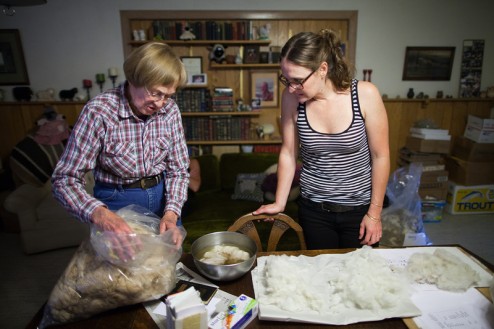
If you look closely at the story of the pokeberry sweater it went through a process of ranching, farming, designing and knitting, and it is these traditions of skilled labor that are responsible for all of our garments and yet we rarely think about the fact that someone took the time to farm, design, and knit or weave our clothes, even though that is the foundation for most of our wardrobes. In each of these stages there are jobs and livelihoods associated with the work. Today, we rarely see anyone in our own communities go to work at the local textile mill or get on their horse to shepherd the flocks, it’s become a way of life that we have temporarily exported and off-shored.
Re-introducing a connection between ranching, farming, and knitting has given us a view into what a vertically integrated textile system would look and feel like. In the case of the pokeberry sweater, the wool was grown on the back of a merino sheep raised 100 miles from San Francisco over a one year cycle, the wool was then transported 55 miles to the place where it was washed, carded and spun, it then travelled another 40 miles to where the dyes were grown and processed, and a final trip of 20 miles to where the sweater was knit.
This entire process required 220 miles of transport within our Northern California Fibershed– a trip that included back and forth transportation between a rancher, a mill owner, a dyer, and a knitter. (Certainly beats the 6,788 mile minimum distance between wool products coming from New Zealand & China to their San Francisco based consumers.)

We know that travel miles are a small fraction of the overall ecological footprint of a garment (around 2-5%), there is a much greater impact made by the wearer once the garment becomes a part of a typical person’s wardrobe. Washing and drying our clothes over their lifespan is where the greatest energy use takes place.
The ecological impact of caring for my pokeberry sweater has been defined by the following: The wool used in this piece was gently processed with mild soap so that the lanolin can still be felt in the yarns, the scales of the wool fibers were left on and not removed with harsh acids. For all of these reasons the sweater is naturally resistant to body odors, moisture (a.k.a. liquid stains) and due to the natural dye variegation– you can not see the effects of wear and tear. After 18 months of use the sweater has yet to need a washing.
With this example of garment production we can identify key attributes that would define a future regional supply chain. 1) The wearer could see the process of creation and could insist on the highest ecological and socially equitable standards for production 2) Regional supply chains would be flexible and could respond instantly to the demands of the wearer .
Prior to the 150 mile wardrobe I was never able to source clothing that was a full match to my personal set of values. It was only when I began working with local farmers and artisans that I found out what it meant to ‘wear what you value.’ The free market (for all the choice it claims to offer), provided no existing supply chain and thus no existing textile product that could hold a close second to the systemic beauty provided to me through the Fibershed prototypes.
Wearing the garments is a constant reminder of the processes that were undergone for their creation, as well as a constant reminder of the great contrast between what I wear daily and what I see on the backs of my friends, neighbors and colleagues.
I assume I’m not alone in my commitment and desire to see our culture last beyond being a simple ‘flash in the pan,’ that is now headed towards the dust bin of history. Many civilizations have come and gone (we wouldn’t be the first of course)…. textile traditions like that of the Minoan societiy lasted 1,600 years before they disbanded from the effects of earthquakes and volcanos. We would be fortunate to have the opportunity to even attempt to initiate a textile tradition as formidable as what our ancestors have manifested over the millennia. We can start our commitment to this great challenge of creating a lasting and aesthetically rich garment culture by beginning with a question (or two): When you get dressed tomorrow, ask yourself where did your clothes come from? If you know the answer to that question you can then ask yourself the second part to that question: Could the system that produced these clothes last for even 200 years to clothe my future great great great grandchildren?
For those who can answer both of those questions we then must ask ourselves how we begin to take textile production off the list of industries degrading the planet, and onto the list of industries that are charged with regenerating it. (A lofty project that involves us all– farmer, maker, and wearer.)
Thank you Sachi Henrietta for your incredible commitment in making the pokeberry & indigo sweater, and Paige Green for photographing the development of its making, and Jean Near for kindly raising your sheep for the last 55 years in such a beautifully humane manner… and thank you pokeberry and indigo plants for your amazing hues.

